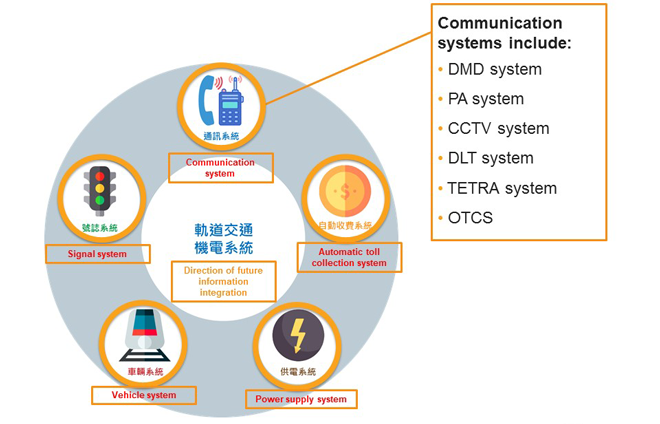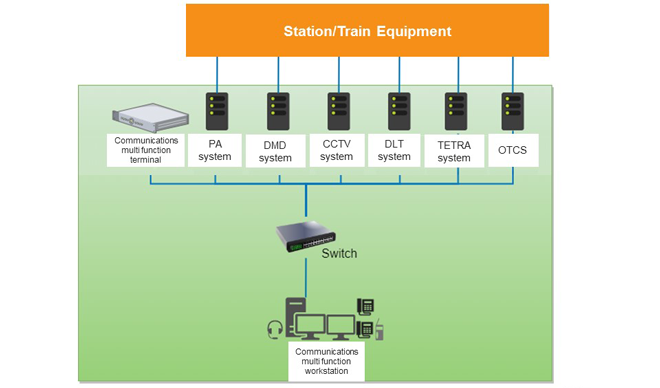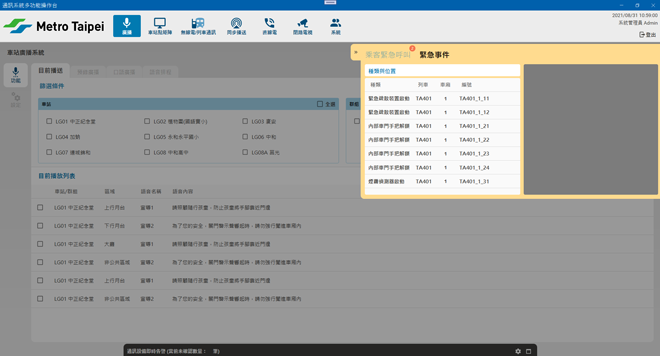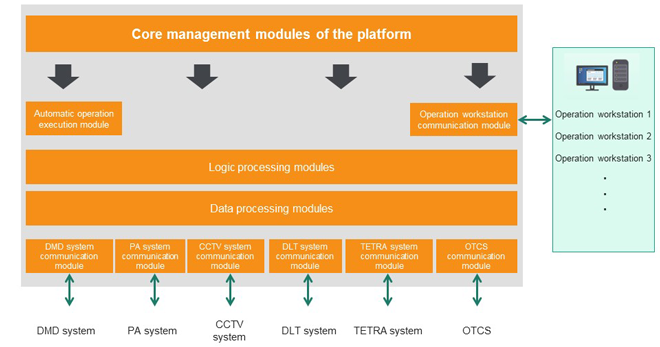Sustainable Future
永續未來
Development and Application of the MRT Communications Multi-Function Terminal (CMFT)
─ Ryan Chen, Engineer, CTCI Advanced Systems Inc., CTCI Group Intelligent Solutions Business
As the Taiwanese No. 1 and one of the top 100 international EPC contractor, CTCI Group has been cultivating the MRT electromechanical engineering field for over 30 years. CTCI is the leading company in MRT electromechanical systems in Taiwan and has earned a wide range of achievements in Taiwan and abroad, including: The first MRT line, the Muzha line, in Taiwan; the subsequent Bannan line, Zhonghe–Xinlu line, Songshan–Xindian line; and the Taichung Metro Green line, Danhai light rail, and the Mass Rapid Transit system in Singapore. CTCI Advanced Systems Inc. (CTCI ASI) of CTCI Group Intelligent Solutions Business is dedicated to the development and introduction of rail transit electromechanical system solutions. With practical system integration experience, the company has helped lower construction costs and optimize operating procedures for rail transit. CTCI ASI aligns its practical actions to two of the 17 UN Sustainable Development Goals (SDGs), namely "Sustainable Cities and Communities" and "Industry, Innovation and Infrastructure," in order to help cities achieve a net-zero and sustainable future. This article will explore and share the implementation and features of the Communications Multi-Function Terminal (CMFT) in MRT electromechanical systems.
Establishment of the MRT Communications System
The MRT system in Taiwan has been developed to international standards. The core electromechanical system of the rail is the most critical part in the MRT system. The normal operation of electromechanical systems is dependent on the implementation of a comprehensive communications system.

Composition of the Rail Transit Electromechanical System
The so-called "comprehensive communications system" is composed of multiple communication subsystems. Since the systems are separated by function, they are often independently implemented and operated, making integration difficult. This is also reflected in the operating interface of the communications system, with its many different interface types and complexity. This requires the installation of large numbers of workstations, wasting space in the control room and power. The complex system causes many problems for the operating personnel and maintenance units. Therefore, the Communications Multi-Function Terminal (CMFT) was born. The complete integration of information by a single system is achieved through the integration of the information and human-machine interfaces of all communication subsystems.

Communications Multi-Function Terminal (CMFT) System Integration Diagram
Complete integration combines information and communication
CMFT integrates all communication systems into a single human-machine interface workstation. The systems include the Public Address (PA) system, Dot Matrix Display (DMD), Closed Circuit TV (CCTV), Direct Line Telephone (DLT), Terrestrial Trunked Radio System (TETRA), On Train Communications System (OTCS), which are interfaced with the Automatic Train Supervision (ATS) system, POWER SCADA system, and Environment Control System (ECS SCADA). Apart from being able to display train operation information, rail system equipment status, and the interfaces of various communication systems on the same terminal, the platform also allows the operators to conduct real-time control, manage and monitor the operating statuses of various subsystems in the control center, depot, station, and the train. It can also issue station fire alarms remotely, monitor the interior of the carriages, and handle emergencies in real time. The design of CMFT is based on intuitive operations. The "system function → control target → settings" operating mode was established so that the operating personnel can operate in this manner on any communication system. A multi-point touchscreen is used as the main interface, which corresponds to the mobile phone and tablet usage habits of modern people. With CMFT, the controller in the control center can use a single interface to conduct comprehensive management and quickly respond to train and passenger incidents, greatly improving the handling efficiency of incidents.

CMFT Platform User Interface
Features and Concrete Benefits of CMFT
The CMFT platform is equipped with a highly integrated, consistent human-machine interface. The human-machine interface and operating procedures can be adjusted and edited and is equipped with a complete backup mechanism. A brief description is as follows: 1.The extensive integration of the communication system interfaces includes systems such as telephone, CCTV, PA, clock, and radio, as well as passenger information display and train communication controls. 2.The uniform style of the communication system human-machine interface unifies the functions of each subsystem, such as communication, operation, control, management, and monitoring. 3.The train operation information, communication system status, and rail equipment status are displayed together. 4.The system can adjust and edit the human-machine interface and operating procedures according to actual operating needs. 5.The complete backup mechanism can provide hot system backups, operating mode downgrades, offsite backups, and database backups.

Operating Structure of the Platform
Since the CMFT integrates the human-machine interface workstations, combining all communication subsystems (TETRA, CCTV, PA, OTCS, DMD, and DLT) into a single interface, it can greatly reduce the amount of workstation equipment and conserve space and power use in the control room, allowing the controller in the control center to conduct comprehensive station management through a single interface and improve incident handling efficiency. Furthermore, the highly modularized design can comply with the MRT company's policy of replacing old with new once every few years (resetting project). CMFT is modifiable and adjustable according to interface needs. It is capable of connecting with the systems and equipment produced by different equipment suppliers. In summary, the implementation of CMFT not only provides numerous operating advantages, it also improves energy savings, carbon reductions, work efficiency and convenience, providing comprehensive benefits.
Future Applications and Development Direction
For the different types of rail transit in Taiwan, including light rail, MRT, railway, and high speed rail, the rail's electromechanical core structures require the installation of communication systems in order to satisfy the basic requirements of operation. The design of the CMFT is modularized. The external interface is capable of copying and modifying the software of modularized interface components. It can be integrated with the systems of other equipment suppliers, thus making it suitable for all rail transit communication systems currently on the market. In the future, CTCI Group will continue to develop the transportation electromechanical engineering field. By using the highly integrated CMFT structure, CTCI can incorporate more diversified equipment and systems and extend the application of the system to smart buildings and smart airports, helping cities implement sustainable management to create a brighter future.
